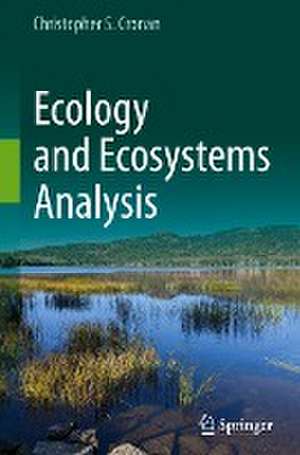Ecology and Ecosystems Analysis
Autor Christopher S. Cronanen Limba Engleză Hardback – 22 noi 2023
Taken as a whole, the chapters of this text are intended to provide a conceptual framework and an intellectual pathway for understanding and interpreting the ecology of the biosphere using elements of population, community, ecosystem, and landscape ecology. Equipped with this toolkit of ecological literacy, readers and students will hopefully be better prepared to make personal, business, and civic or governmental decisions that are consistent with a healthy and sustainable Earth.
Preț: 590.49 lei
Preț vechi: 694.69 lei
-15% Nou
Puncte Express: 886
Preț estimativ în valută:
112.99€ • 118.27$ • 94.04£
112.99€ • 118.27$ • 94.04£
Carte tipărită la comandă
Livrare economică 31 martie-14 aprilie
Preluare comenzi: 021 569.72.76
Specificații
ISBN-13: 9783031452581
ISBN-10: 3031452585
Pagini: 284
Ilustrații: XIII, 284 p. 1 illus.
Dimensiuni: 155 x 235 x 24 mm
Greutate: 0.6 kg
Ediția:1st ed. 2023
Editura: Springer Nature Switzerland
Colecția Springer
Locul publicării:Cham, Switzerland
ISBN-10: 3031452585
Pagini: 284
Ilustrații: XIII, 284 p. 1 illus.
Dimensiuni: 155 x 235 x 24 mm
Greutate: 0.6 kg
Ediția:1st ed. 2023
Editura: Springer Nature Switzerland
Colecția Springer
Locul publicării:Cham, Switzerland
Cuprins
Chapter. 1. Introduction.- Chapter. 2. Life Processes.- Chapter. 3. Environmental Analysis.- Chapter. 4. Population Ecology.- Chapter. 5. Community Ecology.- Chapter. 6. Landscape Ecology and Conservation Biology.- Chapter. 7. Forest Ecosystems.- Chapter. 8. Lake Ecosystems.- Chapter. 9. Stream Ecosystems.- Chapter. 10. Wetland Ecosystems.- Chapter. 11. Marine Ecosystems.- Chapter. 12. Agroecosystems.- Chapter. 13. Ecological Models.- Chapter. 14. Atmospheric Influences, Global Warming, and Climate Change.- Chapter. 15. Tropical Ecology and Deforestation.- Chapter. 16. The Challenges of Human Population Growth.- Epilogue.- Study Questions.- Glossary of Terms.- References.- Index.
Notă biografică
Christopher S. Cronan is a Professor Emeritus in the School of Biology and Ecology at the University of Maine. The author earned a B.A. in ecology at the University of Pennsylvania, a Ph.D. in Biological Sciences at Dartmouth College, and was a Charles Bullard Fellow in Forest Resources at Harvard Forest and Harvard University. He is a former director in the School of Biology and Ecology, served as interim director of the Senator George Mitchell Center, and was founding director of the Graduate Program in Ecology and Environmental Science (EES) at the University of Maine. His research with interdisciplinary teams of scientists included fieldwork in the U.S., Canada, and Europe, and his teaching involved courses in ecology, biogeochemistry, general biology, plant physiology, limnology, natural resource policy, plant biology, and field ecology. He published a textbook entitled Ecosystem Biogeochemistry – Element Cycling in the Forest Landscape with Springer NaturePublishing in 2018 and is the author or co-author of 72 peer-reviewed scientific articles in the journals Science, Nature, BioScience, Water Resources Research, Environmental Science and Technology, Ecological Modeling, Landscape Ecology, Tree Physiology, Biogeochemistry, Analytical Chemistry, Geochimica Cosmochimica Acta, Soil Science Society of America Journal, Environmental Management, Canadian Journal of Forest Research, Oecologia, Forest Ecology and Management, Biological Conservation, Environment, Limnology and Oceanography, Landscape and Urban Planning, Applied Geography, Plant and Soil, Journal of Environmental Quality, Water, Air, & Soil Pollution, Environmental Monitoring and Assessment, Ecological Indicators, and Holarctic Ecology.
Textul de pe ultima copertă
The goal of this book is to convey the rich perspectives, principles, and enchantment of ecology to a broad audience of students and lifelong learners. The book is based on the belief that the science of ecology is best understood by examining familiar ecosystems from the natural world and weaving fresh insights and ecological concepts into an ecosystems framework to reveal the patterns, processes, and interactions that are the foundation of sustainable living systems in our biosphere. In the spirit of that teaching philosophy, the core of this book focuses on specific ecosystems that are familiar to most of us (e.g., forests, wetlands, streams, lakes, and the like).
Taken as a whole, the chapters of this text are intended to provide a conceptual framework and an intellectual pathway for understanding and interpreting the ecology of the biosphere using elements of population, community, ecosystem, and landscape ecology. Equipped with this toolkit of ecological literacy,readers and students will hopefully be better prepared to make personal, business, and civic or governmental decisions that are consistent with a healthy and sustainable Earth.
Taken as a whole, the chapters of this text are intended to provide a conceptual framework and an intellectual pathway for understanding and interpreting the ecology of the biosphere using elements of population, community, ecosystem, and landscape ecology. Equipped with this toolkit of ecological literacy,readers and students will hopefully be better prepared to make personal, business, and civic or governmental decisions that are consistent with a healthy and sustainable Earth.
Caracteristici
Provides a strong emphasis on the analysis of specific types of familiar ecosystems. Explores important global change issues that represent challenging ecological and socioeconomic policy problems. Offers supplemental readings from the primary literature and encourages novel active learning approaches.
